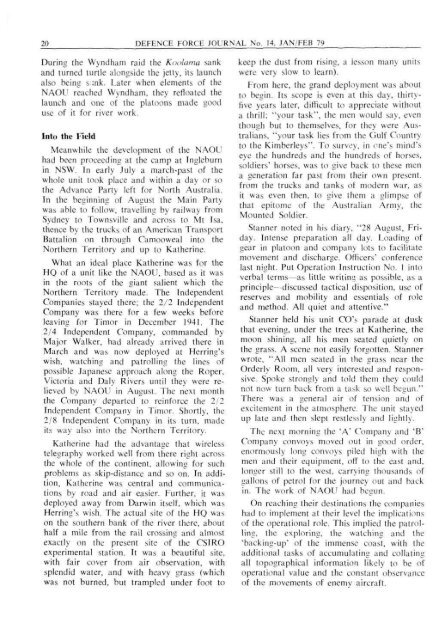ISSUE 14 : Jan/Feb - 1979 - Australian Defence Force Journal
ISSUE 14 : Jan/Feb - 1979 - Australian Defence Force Journal
ISSUE 14 : Jan/Feb - 1979 - Australian Defence Force Journal
Create successful ePaper yourself
Turn your PDF publications into a flip-book with our unique Google optimized e-Paper software.
20 DEFENCE FORCE JOURNAL No. <strong>14</strong>, JAN/FEB 79During the Wyndham raid the Kodama sankand turned turtle alongside the jetty, its launchalso being s::nk. Later when elements of theNAOU reached Wyndham, they refloated thelaunch and one of the platoons made gooduse of it for river work.Into the HeldMeanwhile the development of the NAOUhad been proceeding at the camp at Ingleburnin NSW. In early July a march-past of thewhole unit took place and within a day or sothe Advance Party left for North Australia.In the beginning of August the Main Partywas able to follow, travelling by railway fromSydney to Townsville and across to Mt Isa,thence by the trucks of an American TransportBattalion on through Camooweal into theNorthern Territory and up to Katherinc.What an ideal place Katherine was for theHQ of a unit like the NAOU, based as it wasin the roots of the giant salient which theNorthern Territory made. The IndependentCompanies stayed there; the 2/2 IndependentCompany was there for a few weeks beforeleaving for Timor in December 1941. The2/4 Independent Company, commanded byMajor Walker, had already arrived there inMarch and was now deployed at Herring'swish, watching and patrolling the lines ofpossible Japanese approach along the Roper,Victoria and Daly Rivers until they were relievedby NAOU in August. The next monththe Company departed to reinforce the 2/2Independent Company in Timor. Shortly, the2/8 Independent Company in its turn, madeits way also into the Northern Territory.Katherine had the advantage that wirelesstelegraphy worked well from there right acrossthe whole of the continent, allowing for suchproblems as skip-distance and so on. In addition,Katherine was central and communicationsby road and air easier. Further, it wasdeployed away from Darwin itself, which wasHerring's wish. The actual site of the HQ wason the southern bank of the river there, abouthalf a mile from the rail crossing and almostexactly on the present site of the CSIROexperimental station. It was a beautiful site,with fair cover from air observation, withsplendid water, and with heavy grass (whichwas not burned, but trampled under foot tokeep the dust from rising, a iesson many unitswere very slow to learn).From here, the grand deployment was aboutto begin. Its scope is even at this day, thirtyfiveyears later, difficult to appreciate withouta thrill: "your task", the men would say. eventhough but to themselves, for they were <strong>Australian</strong>s,"your task lies from the Gulf Countryto the Kimberleys". To survey, in one's mind'seye the hundreds and the hundreds of horses,soldiers' horses, was to give back to these mena generation far past from their own present,from the trucks and tanks of modern war, asit was even then, to give them a glimpse ofthat epitome of the <strong>Australian</strong> Army, theMounted Soldier.Stanner noted in his diary, "28 August, Friday.Intense preparation all day. Loading ofgear in platoon and company lots to facilitatemovement and discharge. Officers' conferencelast night. Put Operation Instruction No. I intoverbal terms—as little writing as possible, as aprinciple—-discussed tactical disposition, use ofreserves and mobility and essentials of roleand method. All quiet and attentive."Stanner held his unit CO's parade at duskthat evening, under the trees at Katherine, themoon shining, all his men seated quietly onthe grass. A scene not easily forgotten. Stannerwrote, "All men seated in ihe grass near theOrderly Room, all very interested and responsive.Spoke strongly and told them they couldnot now turn back from a task so well begun."There was a general air of tension and ofexcitement in the atmosphere. The unit stayedup late and then slept restlessly and lightly.The next morning the 'A" Company and 'B'Company convoys moved out in good order,enormously long convoys piled high with themen and their equipment, off to the east and,longer still to the west, carrying thousands ofgallons of petrol for the journey out and backin. The work of NAOU had begun.On reaching their destinations the companieshad to implement at their level the implicationsof the operational role. This implied the patrolling,the exploring, the watching and the'backing-up' of the immense coast, with theadditional tasks of accumulating and collatingall topographical information likely to be ofoperational value and the constant observanceof the movements of enemy aircraft.

















